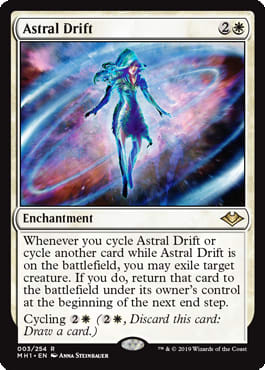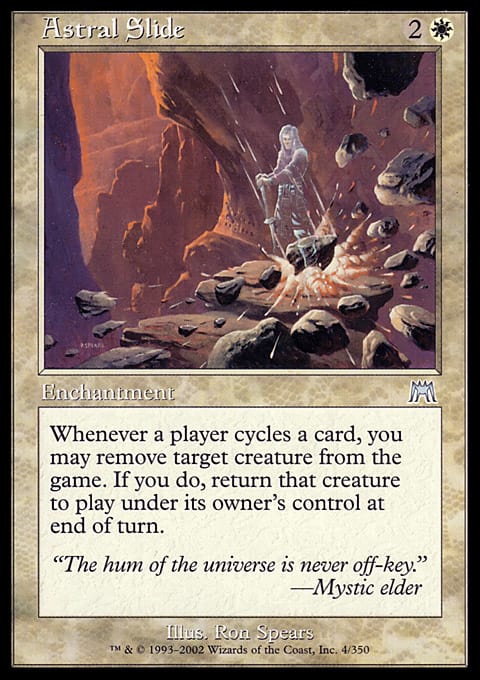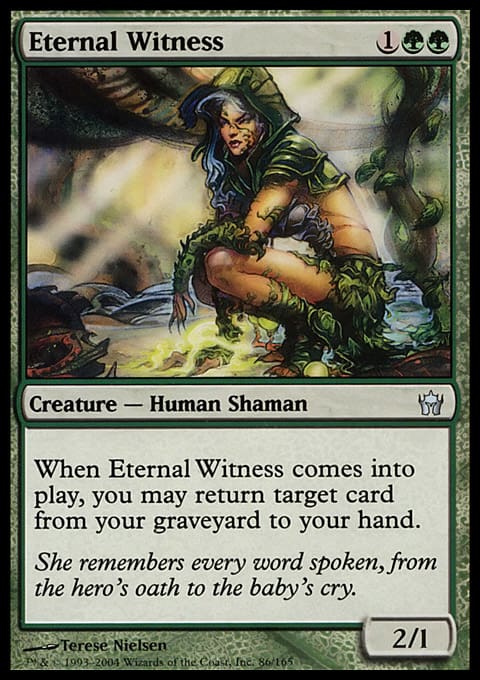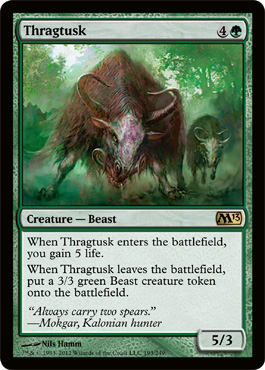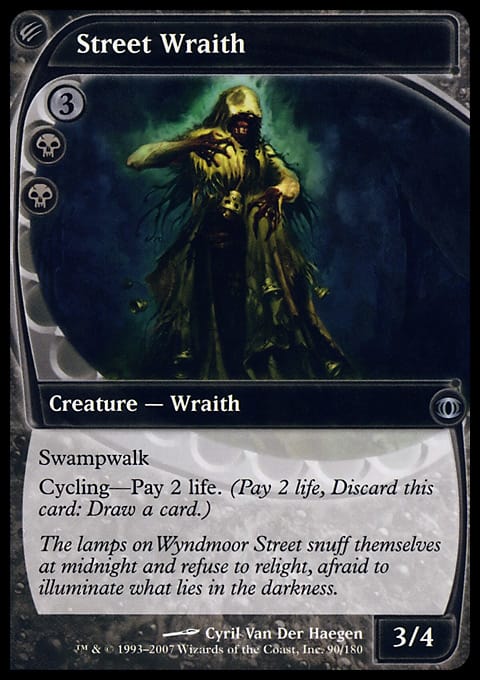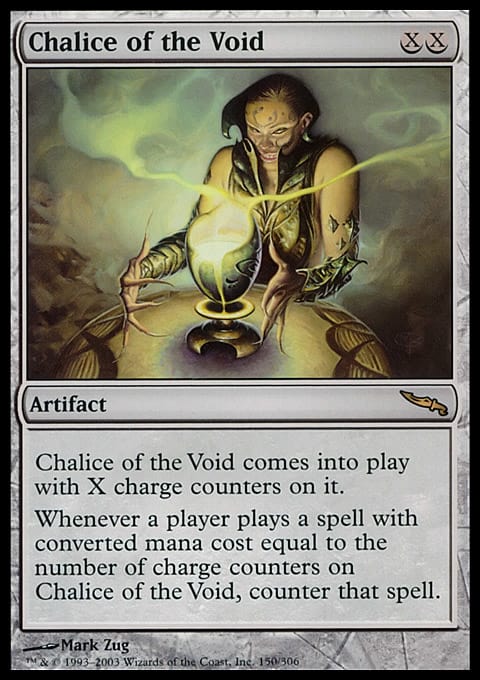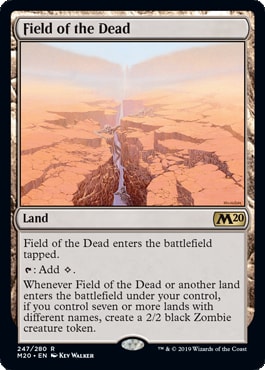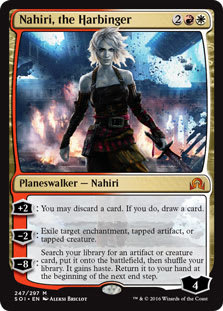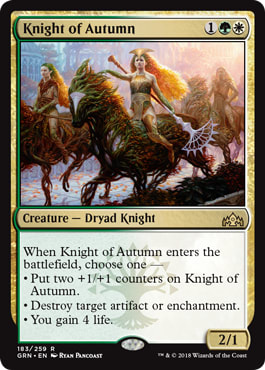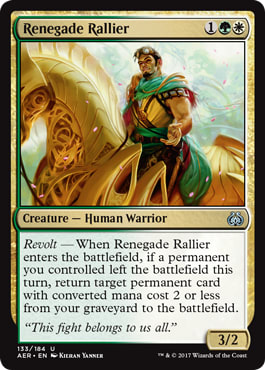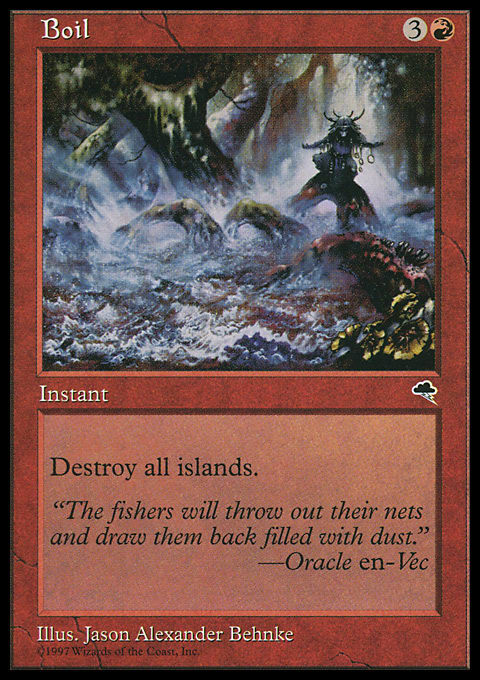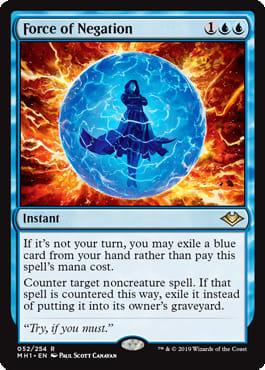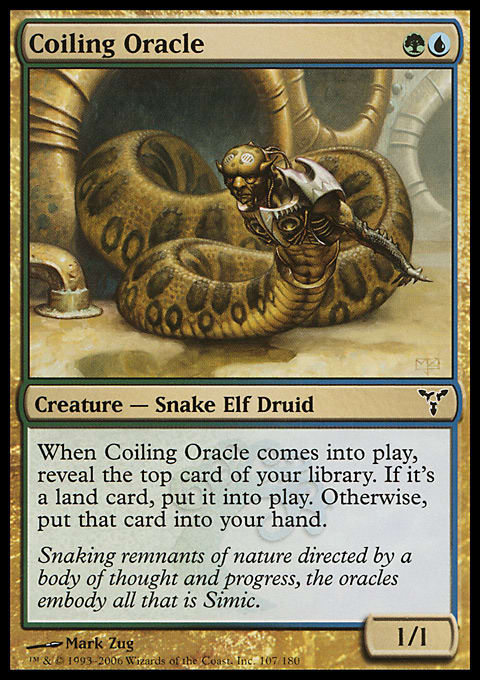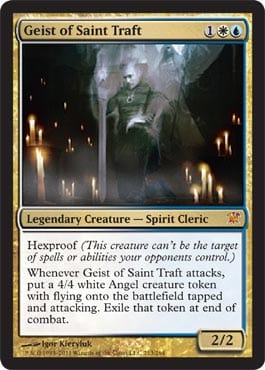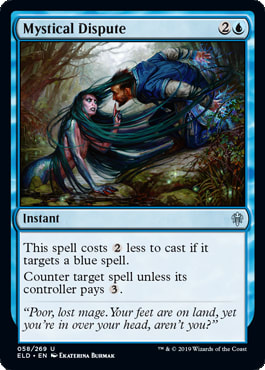Modern Horizons forever changed the landscape of Modern.
Hogaak, Arisen Necropolis was of course the most egregious offender, but Wrenn and Six, Force of Negation, Arcum's Astrolabe, Urza, High Lord Artificer, and friends have all made major marks on the format. However, there were some cards from Modern Horizons that got overlooked.
Astral Drift is a homage to Astral Slide, a card that dominated Standard during its tenure. Astral Slide won the World Championship in 2004 in the hands of a 16 year old Julian Nuijten, and was also a driving force in Extended for a long time.
GW Slide | ONS Standard | Julien Nuijten, World Championship, 1st Place
- Creatures (12)
- 4 Eternal Dragon
- 4 Eternal Witness
- 4 Viridian Shaman
- Instants (6)
- 2 Wing Shards
- 4 Renewed Faith
- Sorceries (13)
- 1 Plow Under
- 2 Akroma's Vengeance
- 2 Decree of Justice
- 4 Rampant Growth
- 4 Wrath of God
- Enchantments (4)
- 4 Astral Slide
- Lands (25)
- 6 Plains
- 7 Forest
- 4 Secluded Steppe
- 4 Tranquil Thicket
- 4 Windswept Heath
- Sideboard (15)
- 3 Circle of Protection: Red
- 4 Oxidize
- 3 Plow Under
- 2 Rude Awakening
- 3 Scrabbling Claws
Astral Drift is not only a homage, it's an improved Astral Slide.
Modern Horizons also reintroduced the Onslaught cycling lands to the format, one of the key elements of every Astral Slide deck ever made. By letting you increase the number of cyclers in your deck beyond just your spells, you gain a huge amount of flexibility in your deck design. But even more important than that is how easy it is to rebuy lands back to your hand.
Life From The Loam plus cycling lands was always at the core of Extended Astral Slide decks, as it provides a slow but never ending stream of cards broken up into many small payments. With a card draw engine already based around cycling cards over and over again, Astral Slide fit in perfectly as a way to utilize those cycles even more. Wrenn and Six is a new card that fulfills a similar purpose at an even higher power level. We've seen cycling lands make their way into Wrenn and Six decks for a while without any benefit for cycling but having a reason to cycle makes this interaction a very important one.
Okay, so we get why Astral Drift can work, but...
Why Do I Want To Play Astral Drift?
Without having seen an old school Astral Slide deck in action, it can be hard to quantify how powerful the effect really is. 3 mana for an enchantment that doesn't do anything on its own or win the game? In Modern? Really? But it's best off to think about it like this. With an Astral Drift in play, all of your cycling lands are now this spell:
Thicket-Drift
![]()
Instant
Thicket Drift can't be countered.
Exile target creature. Return that creature to the battlefield at the end of turn.
Draw a card.
And don't forget we can easily recur this card in multiples via Life From The Loam or Wrenn and Six, meaning casting this card over and over again is a breeze. Starting to look a little better?
Defensively, we can use Astral Drift on our opponent's creature so they can't hit us. Pretty simple, right? You drift out their Tarmogoyf when it attacks, draw a card, and keep going on with your life. There are pluses and negatives here, as you can do great stuff against creatures like Walking Ballista, Batterskull, creature tokens in general, and more that is beneficial, but don't really want to be drifting Primeval Titan or other creatures with enter the battlefield effects.
Proactively, like in Julien's deck, we can use our Astral Drift to flicker our own creatures. This means we can protect them from removal, but more importantly it allows us to reuse enters the battlefield effects over and over again, creating a cascading advantage that is difficult to overcome.
The combination of both of these makes for a very powerful board control deck that typically excels against other decks with creatures but can struggle with non-interactive decks. Modern has been trending fairer lately however, and we have tools for the less fair matchups.
Two Lanes To Drift In
I have brewed up two different Astral Drift Modern decks which we'll be looking at today, but they contain similar elements. We're going to go over each element first, then look at the individual lists and talk about what makes them unique.
Of course, both decks contain the full Life From The Loam plus cycling lands package alongside Astral Drift, which forms the backbone of each deck. With access to this engine you don't need to play many other cycling cards, which is good because most cards with actual cycling aren't very good. This construction also requires you to play a high land count because many of your lands are more like spells than lands.
Having creatures to drift is very important for gaining value in matchups where your opponent isn't playing a bunch of creatures. Eternal Witness is slow but a never ending value engine, while Thragtusk is one of the most exciting cards in the format to drift over and over again. The deck can take a little time to set up, making Thragtusk an amazing comeback card that provides life, blockers, and a threat. Most exciting of all is how well Street Wraith plays with Astral Drift. Having a free cycle is backbreaking and will often lead to huge blowouts, as it allows you to safely tap out for things and still have interaction up.
One of the scary things about playing an engine like Astral Drift is combo decks and fast decks that can get under us. One of the cool things is that most of our important cards cost two and three, and our things that cost one aren't actually spells. This leads to a perfect scenario for Chalice of the Void, a card more often seen in prison decks. It does mean we need to stay away from cards like Path to Exile, but the benefits far outweigh the costs.
The nice thing about our mana base is that we're already playing a bunch of differently named lands, allowing us access to the Field of the Dead endgame that can be very powerful against slower decks. We can even get it back with Life From The Loam if our opponent can destroy it. This is certainly not the primary plan, but a very nice thing to have access to for a very low deck-building cost.
On to the decks!
Naya Slide | Modern | Jim Davis
- Creatures (14)
- 1 Eternal Witness
- 1 Wall of Omens
- 2 Knight of Autumn
- 2 Renegade Rallier
- 2 Thragtusk
- 2 Wall of Blossoms
- 4 Street Wraith
- Planeswalkers (5)
- 1 Nahiri, the Harbinger
- 4 Wrenn and Six
- Instants (2)
- 2 Lightning Helix
- Sorceries (5)
- 2 Wrath of God
- 3 Life from the Loam
- Enchantments (4)
- 4 Astral Drift
- Artifacts (4)
- 4 Chalice of the Void
- Lands (26)
- 1 Forest
- 1 Plains
- 1 Snow-Covered Forest
- 1 Snow-Covered Mountain
- 1 Snow-Covered Plains
- 1 Arid Mesa
- 1 Field of Ruin
- 1 Field of the Dead
- 1 Sacred Foundry
- 1 Stomping Ground
- 2 Temple Garden
- 2 Wooded Foothills
- 4 Secluded Steppe
- 4 Tranquil Thicket
- 4 Windswept Heath
- Sideboard (15)
- 3 Avalanche Riders
- 2 Aven Mindcensor
- 2 Boil
- 2 Celestial Purge
- 2 Damping Sphere
- 1 Engineered Explosives
- 1 Knight of Autumn
- 2 Obstinate Baloth
Our first version of the deck is Naya, looking to take advantage of one of the most powerful planeswalkers in the format.
Wrenn and Six is amazingly good even without cycling lands or being part of an engine, simply ensuring you draw a land every single turn, picking off small creatures, and threatening an ultimate ability that dramatically changes the game. We often see a few cycling lands in Jund and other Wrenn and Six decks just for value, but we take that above and beyond by doing so much with our cycles.
Nahiri, the Harbinger joins Wrenn as a flexible card that can function as a card draw engine, removal, or even a win condition by pulling out a Thragtusk with her ultimate in the late game.
The Naya version of the deck has more of a focus on creatures, as cards like Wall of Blossoms and Knight of Autumn are great early game value cards that get better and better with each time they are drifted. Normally a card like Wall of Omens is going to feel awful in a control or combo matchup, but in this deck they're actually part of the card draw engine. Renegade Rallier does a number of things for the deck, the simplest of which is to ramp out extra lands or return Wrenn and Six and Wall of Blossoms to the battlefield on the early turns, but things start to get wild when you drift it later in the game for major value.
The sideboard contains two more blasts from the past, with Avalanche Riders being the plan against any sort of big mana deck. One Avalanche Riders is okay but being able to drift it out over and over again will quickly leave your opponent in a very awful spot. A benefit of not playing Blue is that we also gain access to Boil, the perfect card to put your Mystic Sanctuary opponents out to pasture.
This version of the deck plays better in a fair environment against other fair or aggressive decks.
Bant Slide | Modern | Jim Davis
- Creatures (9)
- 1 Eternal Witness
- 2 Thragtusk
- 3 Coiling Oracle
- 3 Street Wraith
- Instants (11)
- 3 Force of Negation
- 4 Growth Spiral
- 4 Hieroglyphic Illumination
- Sorceries (5)
- 1 Supreme Verdict
- 4 Life from the Loam
- Enchantments (5)
- 1 Drake Haven
- 4 Astral Drift
- Artifacts (4)
- 4 Chalice of the Void
However, we can also play Blue of our own if things are feeling unfair.
Force of Negation is phenomenal in the deck, helping to shore up weaknesses against non-creature and combo decks. Pairing Force of Negation with Chalice of the Void gives the deck a real solid chance in matchups that would normally be difficult, and when Force of Negation is bad in creature matchups the rest of our deck shines. Keeping our Blue card count high is a little tough, but is worked out with some clever deck-building.
Blue also gives us access to Coiling Oracle, which is superior to Wall of Blossoms as a card draw element. Coiling Oracle can help speed up our early game and then propels us into the late game with the extra land drops.
Blue also gives us a number of great sideboard options. Teferi, Time Raveler and Mystical Dispute are excellent options to battle the more controlling decks of the format, while Geist of Saint Traft can give us a real clock against combo decks when we need to be more aggressive.
If your metagame is more combo and control based, Blue is likely the way the deck needs to go.
Taking A Ride On The Wild Slide
Both of these decks are still in the workshop phase but have shown real promise. The Life From The Loam plus cycling lands engine is phenomenal, and there's no doubt that either of these decks does a great job handling other creature decks and fair decks.
With the format trending fairer lately, it gives engines like Astral Drift more room to breathe, which opens up a whole host of cards that may have not been successful before. There's a good amount of customizability available in both decks which allows a lot of deck-building freedom and ingenuity.
And frankly, they're just a ton of fun too!














